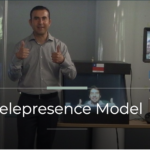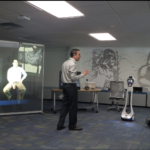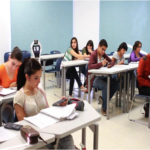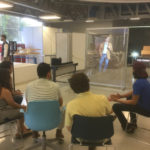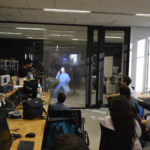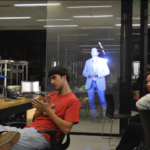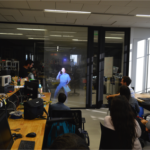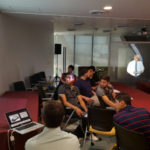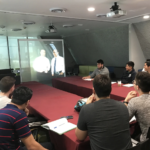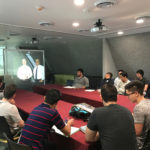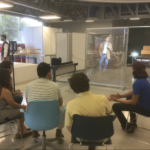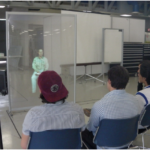Telepresence Avatar Technology Brings Online Professor into the Classroom
“Profesor Avatar” serves students in remote and developing countries through holograms and robots.
In many places around the world, access to quality educational expertise is difficult due to barriers such geographic constraints, safety concerns, and the high cost of the traditional face-to-face model. One group has an innovative solution. Across Latin America, universities are teaming up to benefit students who otherwise might miss out.
“Profesor Avatar” is innovative approach that serves remote areas in developing countries by bringing in experts through holograms and robots.
When barriers keep students from accessing a high quality education, something must be done. This is when online and virtual learning can provide a great solution. Profesor Avatar is a flexible online model that enables universities to reach students through holographic projections and telepresence robots. Students in places with decades of violent conflict, for example, are no longer limited due to their circumstances.
Serving students in situations like these was one of the motivating reasons behind the development of Profesor Avatar. With holographic presence the professor can be seen and heard through a virtual bidirectional appearance at human scale. By virtually eliminating distance, these experts can lecture and share experiences without being physically present. Holograms are projected into a room as realistic, full-motion, real-time 3D images of distant people and objects. This gives a level of realism rivaling physical presence.
Telepresence robots enable videoconferencing on a display that is built-in or added to a robot. Likewise, students can interact with experts displayed on a robot just as if they were physically in the same room. Holographic and Robotic Telepresence enables virtual mobility of experts like professors, mentors, leaders, and entrepreneurs. Peers and students can interact, exchange ideas, knowledge and experiences in a diversity of contexts.
For example, multidisciplinary student teams enrolled in five universities from Mexico, Guatemala, Peru and Chile joined in the “i Challenge” event. In this one-week project, each team was tasked with the construction of a sustainable electric generator using recycled material. Through holographic telepresence, Profesor Avatar provided basic lecturing sessions, tutoring and feedback. Student teams had constant access to faculty and other international experts. As a result of the project, five generators were constructed and every institution donated their generator to a local vulnerable zone.
Profesor Avatar provides incredible experiences for students who otherwise have limited access to quality education. From Argentina to Uruguay to Columbia, Mexico and beyond, just imagine what the future holds as robots and holograms become part of daily life.
Alejandro is looking forward to learning today. While his exposure to top professors has been limited to two-dimensional recorded video lectures, today he will experience having the professor live, virtually in the same room with him, thanks to holography.
As class begins, the clear display standing in the front of the room comes to life and there, in three-dimensions, stands the much revered professor. Though living in a war-torn, guerilla-infested area of Colombia, Alejandro feels as if he is in the same room safely learning.
The Universal Declaration of Human Rights stated in Art.26, “All persons have the right to education,” yet for many places around the world, access to quality education is difficult. It is often due to the high cost of the traditional face-to-face model or to extreme circumstances such as an unsafe region.
What began as an initiative in Mexico at the Instituto Tecnológico de Estudios Superiores de Monterrey (ITESM) to provide access for all has spread across Latin America and as far as Germany and Africa.
The venture called “Profesor Avatar” was aimed to provide access to world-class educators for students in places where opportunities for intercultural interaction are low due to geographical, safety or cost reasons.
In the beginning, three professors at ITESM: Luis Eduardo Luévano Belmonte, Eduardo López de Lara Díaz, and Eduardo González analyzed student-teacher communication challenges and found telepresence technology to be a solution to this challenge.
Holographic Projections and Telepresence Robots
![]() This telepresence model uses real-time holographic projections and telepresence robots in a way that allows personalization of the attention to students and immediate feedback. The professor can be seen and heard through a virtual bidirectional presence which eliminates the limits of distance to enable educators to lecture and share experiences without being physically present.
This telepresence model uses real-time holographic projections and telepresence robots in a way that allows personalization of the attention to students and immediate feedback. The professor can be seen and heard through a virtual bidirectional presence which eliminates the limits of distance to enable educators to lecture and share experiences without being physically present.
It allows virtual mobility of mentors, leaders, entrepreneurs and other guiding tutors from a diversity of contexts to interact with peers and students in a lively telepresence process. They exchange ideas, knowledge, and experiences without having to spend money on travels and other expenses.
The experience generates a cluster of emotions in the student who perceives the presence of the professor or the tutor, who is located in a different geographical area.
They place the estimated cost for a kit of holographic projections at $1,750 USD while a telepresence robot is around $1,995 USD. These tools were selected, in part, because they are available in the market, and do not need professional installers. This constitutes a relatively low cost and enables considerable savings in transportation costs, thus achieving a scalable solution to bring education to the places where needed.
“The possibility of improving the living conditions of people”, “to make a better world for our children”, and “an alternative to drug trafficking” were some of the comments expressed by government authorities of Argentina, Uruguay, Colombia, and Mexico in formal meetings.
A group of professors and specialists pioneered the use of “Profesor Avatar” in an international team teaching project aimed at engineering students from different universities in Latin America.
Holography Supports International Project
To explore adaptation of the model to different learning styles, the “i Challenge” was released to a group of multidisciplinary student teams enrolled in five universities from Mexico, Guatemala, Peru and Chile. The assigned task to every team for the one-week project was the construction of a sustainable electric generator using recycled material. ![]()
Learning based on challenges allowed students to strengthen key competencies and behaviors. Reflective and theoretical learning was promoted through research and analysis about electricity, mechanics, and sustainability. Active and pragmatic learning were encouraged through the technical practice, skills, and abilities to build the sustainable generator.
“Profesor Avatar” was the means to deliver basic strategic lecturing sessions and to provide tutoring and feedback to students all the time from faculty and some other international experts. Strong international collaborative partnerships among institutions and faculty developed because of this initiative.
The one-week i Challenge, required students to construct a sustainable electric generator using recycled material useful to solve a necessity of a local community in poverty. Facing a real problem in a community promotes students’ social commitment awareness, allows them to relate classroom theoretical learning to practice, work collaboratively, and to develop decision-making, communication, and leadership skills.
Basic metrics to evaluate the students work in the one week i Challenge included:
- Energy generation (Watts-hour) 40%
- Low cost (up to 100 USD) 40%
- Social impact (people benefited) 20%
Holography and Robotic Telepresence Solutions and Benefits
The student survey applied at end of project showed the following results:
- 100% considered that telepresence contributed to learning improvement.
- 87% considered that the activity goal was met.
- 97% considered that new skills were developed.
- 98% considered that the Challenge i helped to get them involved in their social, economic and environmental reality.
As a result of the project, five generators were constructed at full completion of the task requirements. Every institution participating in Challenge i donated the generator to a local vulnerable zone.
The Future of TelePresence Technology in Education
“Profesor Avatar” is a scalable, flexible, viable, and profitable model. Its low cost and components availability allows its replication at any school or institution of the world with Internet access. James Fangmeyer is expanding Profesor Avatar in Africa and the United States and developing more portable holographic technologies to reach more people.
In 5 years, it is believed that holographic technology will evolve to a point where it will not require a surface for its projection. It will become an aerial hologram. The anthropomorphic perception of the professor will be more intense and real than now. According to the evolution of technology, it is expected that robots and holograms will be part of daily life and become a tool for education at an even lower cost.
Well done to Tecnológico de Monterrey and Latin American partner universities for finding a way to provide access to top professors and a quality education for all regardless of geographic location or circumstances.

